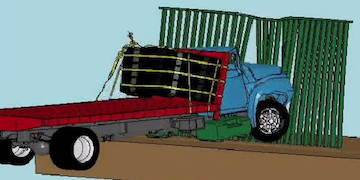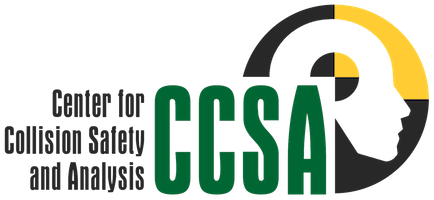
Vehicle Collision Safety
The CCSA team has more than 60 person years of experience in the development of finite element (FE) models of vehicles through reverse engineering. We have created more than 15 vehicle models over the last twenty years. We have advanced the techniques such that more detailed models are generated in shorter periods of time. We have led significant efforts to verify and validate the models to assure their viability for all types of impact analyses.
The team has used these FE models to undertake a variety of simulations to analyze collision effects, study occupant risks for different types of collisions, analyze bumper compatibility in vehicle-to-vehicle crashes, assess means to measure the effectiveness of safety design features (e.g., Safety Energy Absorbing Structures), and investigate the safety implications of future design features (e.g., smaller sizes, use of lightweight materials). This effort includes the maintenance of an extensive array or FE models.

Highway/Roadside Safety
The CCSA team has pioneered efforts to improve roadside safety through the use of advanced computational methods. We have developed dozens of FE models for all kinds of barriers, end treatments, and break-away safety hardware. These have been used to analyze effectiveness under varying impact conditions, assess placement guidelines, and investigate failures.
The CCSA team was the first to model cable barrier systems and used simulation to develop guidelines for the effective placement of barriers on roadside slopes. Simulation analyses have been used to evaluate hardware designs, assess the use of new materials, and evaluate crashworthiness for new barriers as well as improvements to existing hardware designs. The team has also conducted numerous crash tests to capture data for model formulation or to validate simulation findings.

Infrastructure Security
The CCSA has capabilities and experience in the analysis and evaluation of infrastructure security treatments including various types of walls, fences, gates, planters, and barriers. These anti-ram barriers were modeled to allow simulation of impacts by loaded trucks at speeds up to 50 mph. Repetitive simulations were used to optimize designs to assure constructability with available materials and minimize the intrusion upon other aspects of urban environments.
The designs that evolved from the analysis were tested in accordance with State Department or other testing standards to validate effectiveness before being approved for widespread use. Evaluation efforts also included considerations of combinations of barriers, the effectiveness of temporary barriers, and the protection of critical bridge supports from large, high-speed errant vehicles (e.g., bridge abutments).

Occupant Risk Analysis
CCSA efforts included extensive research on vehicle occupant kinematics and injury patterns in collisions. This has covered all types of occupants, positions, and safety devices for the full spectrum of crashes, such as frontal offset, frontal oblique, side impact, and long duration rollover configurations. The team has modeled crash dummies (e.g., Hybrid III and WorldSID), studied effectiveness of restraint systems and child safety seats for varying collision types, and developed an integrated vehicle safety model that facilitates the analysis of restraint systems for various types of impacts.
These efforts often involved deep mining of the NASS CDS, NCAP, and consumer crash test results to identify serious occupant risk issues, validate simulation efforts, and assess potential mitigation options. The application of biomechanics principles and results from injury-based datasets (e.g., CIREN) has led to the identification of the relationships between crash types and likely injuries that has been integrated into emergency response protocols.

Crash Data Analyses (Mining)
The team has undertaken numerous in-depth analyses using various publically available crash datasets. Recent efforts have focused on analyzing factors related to the influence of barriers on rollover crashes, causes of motorcycle crashes, and the nature of impacts into barriers on curved, superelevated roadway sections. A wide array of statistical and graphical means to analyze the data has been employed in efforts to understand crash causation.
The CCSA team has managed the extensive government crash data library and provided critical data to researchers around the world. Management of this knowledge is critical to building upon past efforts to a more complete understanding of collisions and their effects. The findings have often provided the impetus for modeling and simulation of specific types of collisions to better understand the relationship between vehicle structures, collision forces, and occupant risks that led to proposed automotive safety regulations.
Impact & Vehicle Testing
The use of advanced computational methods requires various types of impact testing, including full‐scale crash tests to capture data needed to formulate mathematical models and/or to validate the results predicted by simulation. The CCSA team has managed one of the nation’s major facilities for such testing and conducted hundreds of tests over the last twenty years. These tests have included dynamic impacts of vehicle and barrier components using a pendulum and full‐scale car and truck tests up to 70 mph.
Recent testing has included efforts to analyze vehicle dynamic response and handling on sloped terrain. In these efforts, a variety of devices were used to capture detailed data and imagery of the crash events. The team has demonstrated proficiency in the test set-up and execution for a full spectrum of unique research needs under ISO-based protocols.

Material Characterization & Modeling
Material characteristics greatly influence collision outcomes. The CCSA team has conducted research to develop computational models for various materials and used traditional and innovative materials in the development of hardware for the mitigation of collision forces. These have included modeling windshield glass and characterizing the metals used in vehicles based upon coupon tests in reverse engineering.
Recent efforts have assessed the viability of plastics and composite materials to reduce vehicle weights. These efforts have applied materials science to improve components of vehicles and barriers. Material models have allowed simulation of the collision performance of vehicles and advanced material components. The team has worked to integrate new material models into the multi‐physics code, LS‑DYNA.
Vehicle Dynamics Analyses
The CCSA team has become recognized as experts in the application of vehicle dynamics analysis tools in the understanding of the vehicle-to-barrier interface in collisions. Since vehicles are a sprung mass, the interface is influenced by vehicle mass, speed, orientation, and surface features. Recent efforts led to guidelines for the effective lateral placement of cable barrier systems on highway medians and the influences of curved, superelevated roadway section.
The team has also been involved in the assessment of handling response of production hybrid vehicles through simulation and field testing. The team is currently involved in research aimed at formulating a realistic dynamic test to evaluate roof crush strength for new vehicles.
Computational Methods & Technology
CCSA efforts have included research that produces benchmarks for testing simulation software, development and testing of new algorithms in simulation software, the formulation of material and failure models, and evaluations of alternative simulation methods. These have advanced the tools and techniques available for continued application of computational methods in collision safety and analysis.
The team contributed to recent efforts to develop protocols for the verification and validation of simulation results against crash test data. Initial efforts involved beta testing of the support software and later efforts aimed to assess the consistency and relevance of the metrics generated by the procedure. Recommendations were generated to enhance the protocols as well as improve the production of the comparative summaries.
